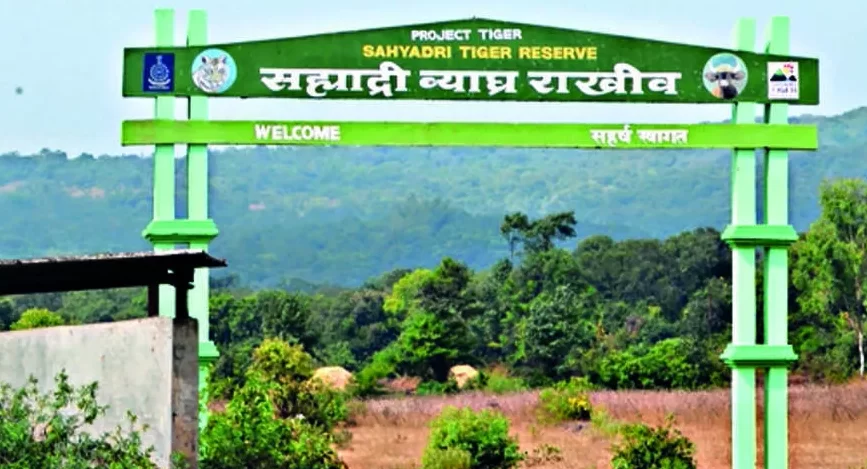Why in the news?
The Maharashtra forest department is preparing to translocate several tigers from the Tadoba-Andhari Tiger Reserve (TATR) located in Chandrapur to Sahyadri Tiger Reserve, which is the only tiger reserve in the western region of the state.
About Sahyadri Tiger Reserve
- Location: Situated within the Sahyadri Ranges of the Western Ghats in Maharashtra.
- Composition: It encompasses the Koyna Wildlife Sanctuary (north) and Chandoli National Park (south), formed by merging these two areas in 2007.
- Geography: The region includes landmarks like the Koyna Dam, the Warna River, and various small rivers and streams originating from the Western Ghats and flowing eastward.
- Historical Significance: Traces its history back to the Maratha Empire, featuring forts associated with Shivaji Bhonsle, the first Maratha Emperor, including the legendary temple where he received the Bhavani Sword.
- Habitat Description: Characterised by undulating terrain with steep escarpments along the western boundary. Notable for its numerous barren rocky plateaus (“Sadas”) with sparse vegetation, overhanging cliffs, and dense thorny bushes. Considered unique for its abundance of climax and near-climax vegetation, with minimal potential for future anthropogenic disturbances.
- Flora:
- Encompasses moist evergreen, semi-evergreen, moist, and dry deciduous vegetation.
- Rich in medicinal and fruit-bearing trees, alongside commercially valuable hardwood species.
- Fauna:
- Predominantly inhabited by carnivores such as tigers, leopards, and smaller felines, as well as wolves, jackals, and wild dogs.
- Large herbivore population includes various deer species like Barking Deer and Sambar, alongside other mammals such as Indian Bison, Sloth Bear, Mouse Deer, Giant Indian Squirrel, and Macaque.

Tiger Translocation Project
- The Sahyadri Tiger Reserve (STR) is among just five tiger reserves in India.
- The other four reserves without any tigers within their boundaries are:
- Kaval in Telangana, Kamlang in Arunachal Pradesh, Dampa in Mizoram, and Satkosia in Odisha.
- The translocation initiative is a strategic component of a broader plan aimed at rejuvenating the tiger population in the forests of the northern Western Ghats.
- Senior officials from the Maharashtra forest department have stated that they are awaiting approval from the Union Environment Ministry to proceed with tranquilizing the tigers in TATR for relocation.
- The National Tiger Conservation Authority (NTCA) approved the translocation plan in October 2023.
- Initially, either a male tiger or a pair of male and female tigers will be moved from the Tadoba-Andhari Tiger Reserve (TATR) to STR as part of the first phase of the translocation process.
Why is the Project Important?
- The translocation initiative is a significant measure in the conservation efforts for tigers within the forests of the northern Western Ghats.
- These forests serve as a crucial wildlife corridor connecting Maharashtra and Karnataka.
- This corridor facilitates the movement and connectivity of tiger populations across various reserves. (Sahyadri Reserve, Radhanagari Wildlife Sanctuary, Amboli Reserve Forest, Mhadei Wildlife Sanctuary in Goa, and Bhimgad Wildlife Sanctuary and Kali Tiger Reserve in Karnataka).
- This information is based on the All India Tiger Estimation report of 2023, as stated by the government.
- The 2023 tiger population estimation report emphasised the risks faced by the wildlife corridor connecting STR with forests in Karnataka.
- Threats include mining operations, road construction projects, and human settlements encroaching upon the corridor.
Tiger recovery project
Phase-I
- Phase-I includes habitat preparation for reintroducing the big cats.
- It involves increasing prey numbers, enhancing forest protection measures, and constructing a temporary enclosure for the soft release of the tigers.
- Prey base augmentation efforts commenced in December 2021 by the forest department.
- Chital and Sambar deer were sourced from Katraj zoo. They were released into the forests of STR as part of this initiative.
Phase-II
- The translocation of Tigers.
- The next step will involve relocating tigers from the Pench Tiger Reserve landscape, spanning Maharashtra and Madhya Pradesh.
- Overall, the plan entails moving a total of eight tigers, comprising three males and five females.
Translocation is not a one-time action but a long-term process. It’s imperative to concentrate on conserving the entire landscape to ensure the sustained population of tigers in the long run.


Leave a Reply
You must be logged in to post a comment.